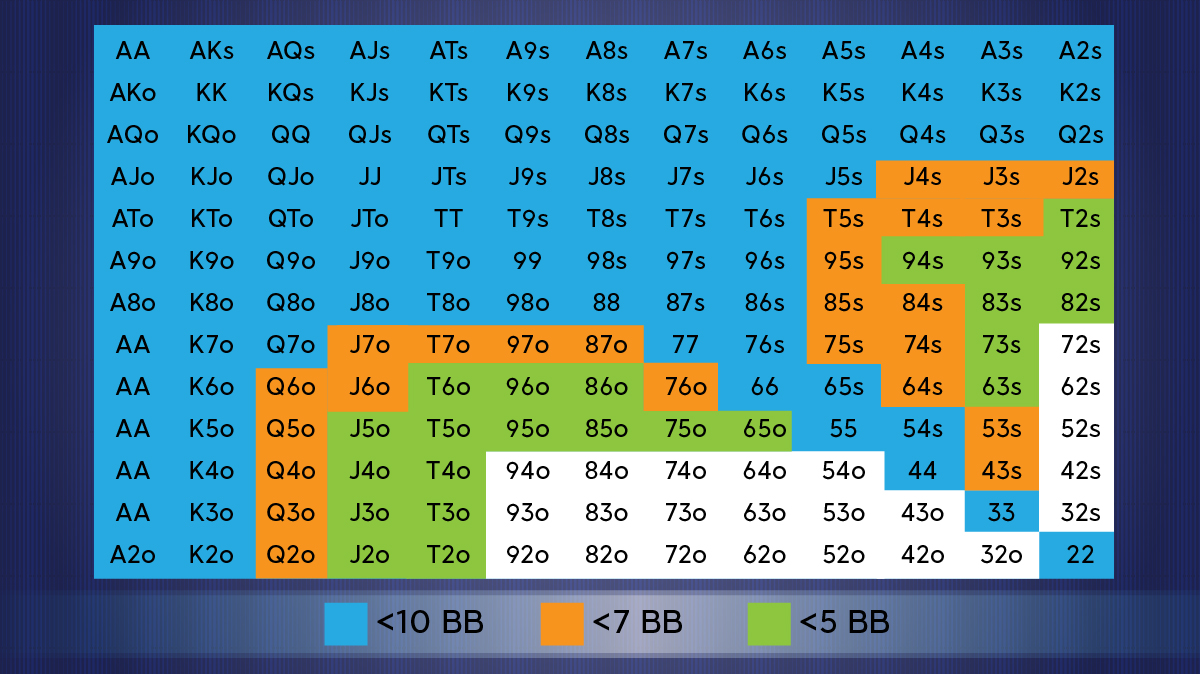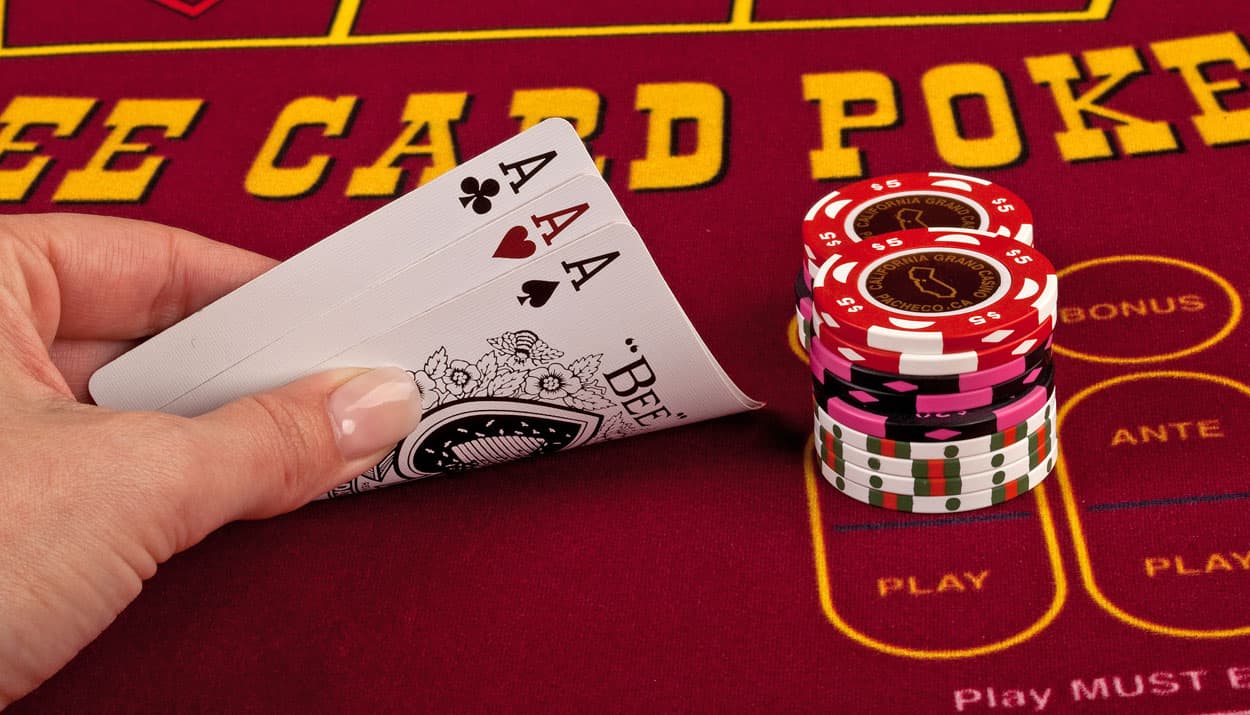What Does Push In Poker Mean
Posted By admin On 18/03/22This page is based on a contribution from Paul Welty.


Wrapping your head around push/fold will also help you make better decisions in other areas of the game. In many ways, everything the top pros are doing today is built on push/fold. The Nash push/fold strategies you’ll see in this poker strategy guide are used in Texas Hold’em games where it’s just you and one other player at the table. Push/Fold is a common strategy used in tournaments in which you either go all-in preflop or fold. Push/fold should be utilized when your stack becomes short — around 15 big blinds (bb) or fewer. There are a ton of different push/fold charts available, but we will be using the program that those charts get their data from — ICMIZER. The BB folds as does the player on the button, who sheepishly admits that he only had 7-high. By pushing 'all-in', you committed all of your chips to the pot. If somebody had called you and had you 'covered' (meaning, had as many chips as you did), then you could have potentially lost your entire stack.
Push is related to Contract Rummy, but there are some important differences: Push is a partnership game, and the draw and discard mechanism is different.
This is a discussion on Commonly Used Poker Abbreviations and Terms. Depending on what you imply afterwards Push can definitely mean 'push all in,' but I think it can also mean 'push the action.
Players and Cards
Push is for four players, two against two in fixed partnerships; as usual, partners sit facing each other. Two standard packs of cards are used, including 4 jokers, making 108 cards in all. The jokers and twos are wild cards.
Outline of the Game
There are 5 deals. The first deal is 6 cards to each player, the second 7, the third 8, the fourth 9, and the fifth 10 cards. During each hand, the object is to get rid of as many cards as possible from your hand by playing them to the table as melds. When one player gets rid of all their cards, the cards remaining in the other team's hands score penalty points. The team with the lower total of penalty points after the fifth hand wins.
Poker Online Real Money
Melds
As in most rummy games, the possible melds are sets of equal cards and runs of consecutive cards in the same suit. Wild cards can be used as substitute for any number of cards in a set or run. The minimum size of sets and runs is three cards, but a longer run is required for the initial meld in some deals.
- Sets
- A set consists of three or more cards of equal rank - for example three sevens or four queens. Since a double pack of cards is used there are two of each card, but a set cannot contain two cards of the same suit. Therefore a set cannot contain more than four cards. However, a player can meld two separate sets of the same rank, for example 8-8-8 and 8-8-8
- Runs
- A run consists of three or more cards of the same suit in sequence, such as 3-4-5-6 of spades, or 9-10-J of diamonds. Ace can count as high (as in J-Q-K-A) or low (as in A-2-3-4), but not both (K-A-2-3 is not allowed). A player can meld two separate runs in the same suit, for example 4-5-6-7 and 8-9-10-J, or these eight cards could be melded as a single run: 4-5-6-7-8-9-10-J, but once melded, runs cannot be split up or joined together, only extended.
- Wild cards
- Twos and jokers are wild and can be used in any set or run to represent any desired card. If a meld consists entirely of wild cards or has just one natural card and the remainder wild, the player must specify whether it is meant to be a set or a run. In the case of a run, the player must specify exactly what any wild card represents; in the case of a set it is only necessary to specify the rank of the set.
- For example, if you put down 6-2-joker you must say whether it is a set of sixes or a run in diamonds, and if it is a run you must specify whether it is 4-5-6, 5-6-7 or 6-7-8.
- A two can also be used as a natural card (i.e. representing itself) in a run such as A-2-3-4.
Initial Meld Requirements
In each deal, there is a minimum requirement for each player's initial meld, as follows:
| Deal No. | Cards dealt | Initial meld |
|---|---|---|
| 1 | 6 | 2 sets of three |
| 2 | 7 | 1 set of three, 1 run of four |
| 3 | 8 | 2 runs of four |
| 4 | 9 | 3 sets of three |
| 5 | 10 | 2 runs of five |
The deal
The first dealer is chosen at random and the turn to deal passes clockwise. The dealer deals the appropriate number of cards (see above table) to each player, one at a time. The next card is placed face up to start the discard pile, and the remaining undealt cards are placed face down beside it to form the stock. The first face-up card is not allowed to be a wild card; if the card turned up is a two or joker, the dealer buries it in the stock and turns up a new card to start the discard pile.
The play
The player to dealer's left begins, and the turn to play continues clockwise. A turn consists of drawing, melding and discarding.
- If you want the top card of the discard pile, take it and add it to your hand.
- If you do not want the top card of the discard pile, take a face-down card off the top of the undealt stock cards, put it on top of the card from the discard pile, and push these two cards to the opponent on your left (hence the name of the game). The opponent must add these two cards to their hand, and you then draw the next card from the stock and add it to your own hand. Because of the pushing, players can sometimes accumulate quite a large number of cards in their hands.
What Does Push In Poker Meaning

What Does Push Mean In Poker

The objective is to meld or discard all of one's cards, and the play continues until one of the players manages to 'go out' by getting rid of all the cards from their hand. It is possible to go out in the melding part of a turn, by melding all of your cards, or to meld all but one of your cards, and go out by discarding your last card.
In the unlikely event that the stock runs out, then as soon as a player wishes to draw from the stock and there is no card available the play ends.
The scoring
As soon as a player goes out, the hand is scored. The team of the player who went out counts nothing for this hand (the cards belonging to the partner of the player who went out do not count). The two opponents count the total value of cards remaining in their hands. If the stock ran out before any player could go out, both teams score the penalty points in their hands. The values of the individual cards is as follows:
| each 3, 4, 5, 6, 7, 8, 9 | 5 points |
| each 10, J, Q. K | 10 points |
| each ace | 15 points |
| each two or joker | 20 points |
The value of the losing team's cards is added to their running total. The score is kept like this:
| WE | THEY | |
|---|---|---|
| 6 | --- | 40 |
| 7 | 120 | 40 |
| 8 | 120 | 100 |
| 9 | 300 | 100 |
| 10 | 300 | 280 |
In this example, 'THEY' win after the last round.
Variation: Cap-It

Wayne Ostrowski describes a variation known as Cap-It in which 10 cards are dealt in each of the 5 rounds. The contracts are the same as in Push, except for the fifth round, in which a run of 3 and a run of 7 are needed.
There are no partnerships, and it is possible for 5 or 6 to play, in which case a third deck of cards with its two jokers is added.
All contribute equally to a pot at the beginning. The winner of each round takes an agreed amount from the pot and the remainder is collected by the overall winner - the player with the lowest cumulative score after round 5.